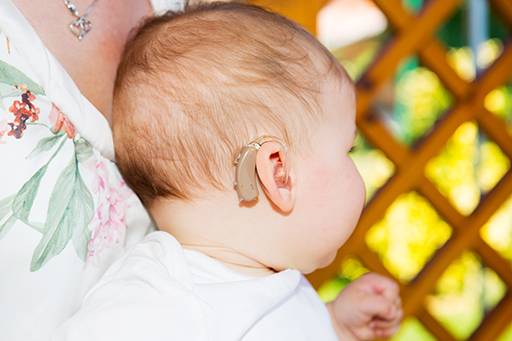Adapting the environment for a child with ASN
All children have a right to take part in and join in with activities in their setting alongside their peers. An inclusive environment strives to meet this expectation and enable participation.
The next activity examines how the environment can be adapted to meet the needs of a deaf child.

Activity 1.4 Barriers for hearing impaired or deaf children
Ade is three years old and has recently joined your nursery. She is profoundly deaf and is waiting to have a cochlear implant. A cochlear implant is a hearing device that converts sound into electrical signals. It is fitted during an operation (National Deaf Children’s Society, 2019).
You have watched Ade in the nursery and have noticed how much she likes to play at the water and sand area when no one else is there and it is quiet. You have noticed that Ade is not joining in social activities with other children and she often stands aside to watch others closely. Ade likes to help adults with everyday tasks like tidying up, sweeping up or preparing food for a snack. Sometimes when Ade is deeply involved in water play, she vocalises with excited, high-pitched sounds.
What can you do to support Ade’s learning? Before you answer this question, you might find it helpful to find out more about the experience of being deaf. Have a look at these two websites:
Early years education [Tip: hold Ctrl and click a link to open it in a new tab. (Hide tip)]
Write a list of the ways that you could support Ade.
What might you change about what you do?
What might you change about the nursery? Think about different sensory experiences and ways to support social interaction.
When you have finished click on ‘Save and reveal discussion’ to gain more ideas.
Discussion
It is very important that ELC staff understand how a nursery space – indoors and outdoors – is experienced by a child who is deaf. This experience will influence both social interactions and learning. Making practical changes and thinking differently about communication to make it easier for a child who is deaf to enjoy and explore their play with other children is likely to benefit all the children in the setting.
Here are some practical ideas that could be taken to support Ade:
- When communicating with Ade, make sure you are at her level (as you would with all young children). It helps to have eye contact and that Ade can see your face, mouth and expressions. Leave plenty of time for Ade to process your communication.
- Model and value different ways of communicating. Explore how facial expressions and gesture and vocal sounds can promote communication. Again, this will be useful for all children in your setting. Reading emotions through facial expression is an important social skill.
- Model your understanding of Ade’s communication to support children’s understanding of Ade’s communication. When Ade vocalises her enthusiasm for play you can mirror Ade’s enthusiasm with words: ‘Ade, you love the water don’t you?’. You are valuing her communication and helping other’s to understand her communication.
- Ade likes to play in areas that are quiet. How can you change the sound in your nursery? Can you reduce echo and clatter with more soft furnishings? Could rugs or curtains be used here?
- Can you set up more sensory activities like sand and water play to ensure children are more evenly spread across these resources? This might reduce the noise and make more areas appealing to Ade. Consider clay, soil/mud, gloop or coloured rice.
- Introduce more multisensory experiences, such as a light box, colour paper and fabrics. Make more opportunities for baking, a sensory experience that suits Ade’s preference for being with adults or it could be one adult with a small group of helpers.
- Introduce more visual aspects to all children’s experience of nursery. Introduce signing or actions along with singing. Bring props to story telling.
- Support Ade’s interest for helping adults by making sure child-sized tools are available, for example, a sweeping brush. This might encourage other children to join her in a shared, sociable task.
- Research information about cochlear implants so that you are knowledgeable and confident about using hearing technologies. This is important so that practitioners can work with her family and help to support Ade before she goes to hospital, as well as being ready to meet her needs when she returns to nursery.
As you’ll have seen, the National Deaf Children’s Society have several resources and tools for practitioners and provides more insight into the experience and identity of being deaf.
Deaf children may struggle with self-esteem and confidence because of the communication barriers they experience when they are poorly supported in mainstream settings. Part of your role is making sure you are building Ade’s confidence by changing your practice to include her in your nursery community. This includes learning more about the positive experiences associated with being deaf as you tune into and value Ade’s experience of the world.
In this example you have explored some ideas of how you can adapt the environment for a deaf child. However, they are not the only ones you have to address in order to ensure you are including children with a disability such as deafness. Deaf children may struggle with self-esteem and confidence because of the communication barriers they experience, so praising appropriately and being positive about deafness is important.
1.3 Creating an inclusive environment
